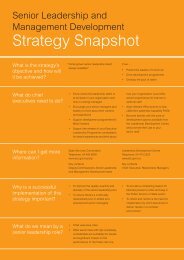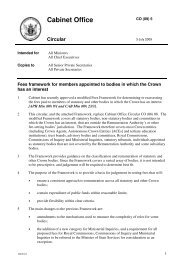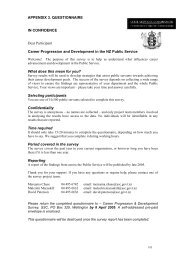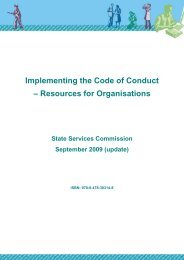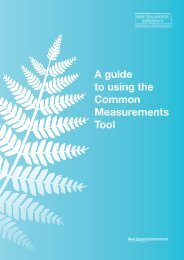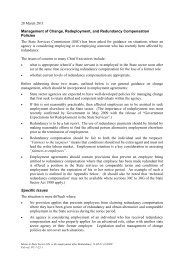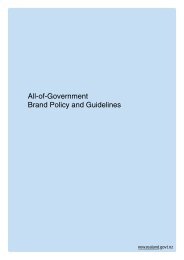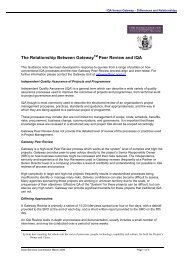Better Public Services Advisory Group Report - November 2011
Better Public Services Advisory Group Report - November 2011
Better Public Services Advisory Group Report - November 2011
Create successful ePaper yourself
Turn your PDF publications into a flip-book with our unique Google optimized e-Paper software.
• Regional offices: Rationalising office space in Wellington and the regions could also<br />
save money. There is potential for agencies to reduce their collective footprint,<br />
improve mobility and co-locate with non-government organisations. Unnecessary<br />
cost, for government agencies and those who interact with them, could be reduced by<br />
requiring all agencies to use consistent regional boundaries. Currently these are<br />
defined variously, undermining the opportunities for cooperative use of resources and<br />
confusing service delivery organisations, citizens and businesses.<br />
• Front line offices: For example, the Ministry of Social Development’s Community Link<br />
consolidation is expected to save the Housing New Zealand Corporation over<br />
$0.5 million a year.<br />
• Agencies: The optimal size of state entities is debated, but evidence, including from<br />
the <strong>Better</strong> Administrative and Support <strong>Services</strong> programme, indicates that having<br />
many small agencies generates diseconomies of scale. The gains from consolidating<br />
go beyond efficiencies in running costs: they include more co-ordinated activity,<br />
pooled expertise, lower transaction costs and fewer and easier points of interaction for<br />
citizens and businesses. Whilst the <strong>Advisory</strong> <strong>Group</strong> does not advocate a first<br />
principles machinery of government review, its judgement is that there is opportunity<br />
to realise worthwhile gains from practical, considered steps to:<br />
- better align agencies around results<br />
- reduce duplication and fragmentation 41 , and<br />
- re-assess whether Crown entities can be incorporated back into the core Crown, in<br />
some cases as executive agencies; and<br />
Back-office operations: There is already a drive for smarter and leaner back-offices,<br />
through initiatives such as the <strong>Better</strong> Administrative and Support <strong>Services</strong> project 42 .<br />
The 33 agencies surveyed in 2010 reported spend of $1.85 billion on administrative<br />
and support services, representing nearly 10% of organisational running costs. The<br />
breakdown of costs by activity is set out in the table below. Whilst considerable<br />
variation between agencies was apparent, there is a clear conclusion that economies<br />
of scale drive down costs with smaller agencies being the least efficient: although, as<br />
the bulk of costs are in medium to large agencies, they provide the opportunity for the<br />
greatest cost reductions. The Ministry of Economic Development and Department of<br />
Internal Affairs’ consolidation of procurement is expected to generate savings of more<br />
than $500 million over the next five years. The leadership changes in Chapter 5 will<br />
drive this faster.<br />
41 Refer Annex 6 for a list of current agencies.<br />
42 See the Treasury, Administrative & Support <strong>Services</strong> Benchmarking <strong>Report</strong> for FY 2008/09 and FY 2009/10, April<br />
<strong>2011</strong>, available at: www.treasury.govt.nz/statesector/performance/bass/benchmarking/2008-10<br />
43




